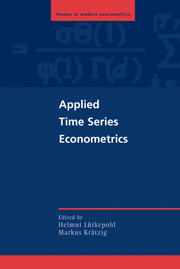Book contents
- Frontmatter
- Contents
- Preface
- Notation and Abbreviations
- List of Contributors
- 1 Initial Tasks and Overview
- 2 Univariate Time Series Analysis
- 3 Vector Autoregressive and Vector Error Correction Models
- 4 Structural Vector Autoregressive Modeling and Impulse Responses
- 5 Conditional Heteroskedasticity
- 6 Smooth Transition Regression Modeling
- 7 Nonparametric Time Series Modeling
- 8 The Software JMu⌉Ti
- References
- Index
2 - Univariate Time Series Analysis
Published online by Cambridge University Press: 23 November 2009
- Frontmatter
- Contents
- Preface
- Notation and Abbreviations
- List of Contributors
- 1 Initial Tasks and Overview
- 2 Univariate Time Series Analysis
- 3 Vector Autoregressive and Vector Error Correction Models
- 4 Structural Vector Autoregressive Modeling and Impulse Responses
- 5 Conditional Heteroskedasticity
- 6 Smooth Transition Regression Modeling
- 7 Nonparametric Time Series Modeling
- 8 The Software JMu⌉Ti
- References
- Index
Summary
Characteristics of Time Series
The first step in building dynamic econometric models entails a detailed analysis of the characteristics of the individual time series variables involved. Such an analysis is important because the properties of the individual series have to be taken into account in modeling the data generation process (DGP) of a system of potentially related variables.
Some important characteristics of time series can be seen in the example series plotted in Figure 2.1. The first series consists of changes in seasonally adjusted U.S. fixed investment. It appears to fluctuate randomly around a constant mean, and its variability is homogeneous during the observation period. Some correlation between consecutive values seems possible. In contrast, the second series, representing a German long-term interest rate, evolves more slowly, although its variability is also fairly regular. The sluggish, longer term movements are often thought of as a stochastic trend. The third series represents German gross national product (GNP). It appears to evolve around a deterministic polynomial trend, and, moreover, it has a distinct seasonal movement. In addition there is a level shift in the third quarter of 1990. This shift is due to a redefinition of the series, which refers to West Germany only until the second quarter of 1990 and to the unified Germany afterwards. Although German reunification took place officially in October 1990, many economic time series were adjusted already on 1 July of that year, the date of the monetary unification. Finally, the last series in Figure 2.1 represents the daily DAFOX returns from 1985 to 1996. The DAFOX is a German stock index.
Information
- Type
- Chapter
- Information
- Applied Time Series Econometrics , pp. 8 - 85Publisher: Cambridge University PressPrint publication year: 2004
Accessibility standard: Unknown
Why this information is here
This section outlines the accessibility features of this content - including support for screen readers, full keyboard navigation and high-contrast display options. This may not be relevant for you.Accessibility Information
- 15
- Cited by
